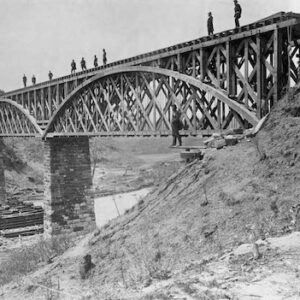| Credit: | by Russell (Andrew J.) |
|---|---|
| Date: | 1863.04.18 |
| Negative Size: | 14 in. x 17 in. |
| Locations & Lines: | Aquia Creek & Fredericksburg Railroad (AC&F); Potomac Creek VA; Virginia |
| Military Units: | US Military Railroads (USMRR); US Army |
| Persons: | Smeed (Eben C.) |
| Structures & Establishments: | AC&F Bridge (b) (Potomac Creek VA) |
| Sources: | Boston Athenaeum; Cowan Auctions; Huntington Library; J. Paul Getty Museum; Lee Gallery; Library of Congress; Rosenbach Museum; San Francisco MOMA; Virginia Historical Society |
$2.99
File Details: AACRm, 360 DPI, JPEG, Original Photograph, 2.7 Mb
Image ID: AACR
Russell, United States Military Railroad Photographic Album. No. 237. Potomac Creek Bridge, Aquia Creek & Fredericksburgh Railroad, April 18, 1863.
Herman Haupt’s personal copy of this photo includes two pages of text handwritten by Haupt: When General Hooker was preparing for his forward March against Richmond he telegraphed to me requesting an interview at his headquarters. I reported early next morning where he placed in my hands his plans of campaign with strict injunctions to secrecy stating that no one be his chief of staff had been advised of his [movements?], but that, as success would be dependent upon my ability to [restore?] [broken?] communications and forward supplies he considered it necessary to advise me of his plans. I [something] the papers while he went to [something] and on his return assured him that I would be ready.
The bridge across Potomac Creek was a temporary structure on trestles. Gen’l Doubleday, very unwisely, had cut off all the timber in the valley for some distance above the bridge, thus endangering the structure in case of a freshet. I concluded to erect a new truss bridge sitting on the old stone piers and take down the trestle work. We had a good supply of of two inch plank and I prepared a design which my man E. C. Smeed said he could put together about as fast as a day [something] [something]. I directed him to proceed and erect the new bridge with all possible expedition. When the work commenced, I was [something] [something] by General Hooker. When I reported he said “I am informed that you are building a new bridge across Potomac River” I replied that I was and explained the necessity. He said that he could not permit it, that he was [there?] [something] his [something] to commence his forward movement and could not permit any [delay?] by a break in his communications. I replied that I did not propose to break the communications. How can you, said he, “take down the bridge and build another without breaking the communications.” I replied General, that is my business. It is for you to inform me what you desire to have done and for me to find the best way to do it. All I have to say is that the old bridge will be [something] and a new and safer one erected and not a single train will be delayed for a single hour during the reconstruction. The General and his chief of staff General Butterfield both said that they did not see how it could be done but if I felt confident I could go ahead. I offered to go into an explanation if they [desired?] it but they expressed a willingness to accept my statement. The bridge was built without any interruption to the trains and in ample time for the [something] movements. I do not remember the exact time but it was a very few days.
I was not under the orders of any of the Generals in the field. My authority [over?] the construction and operation of the railroads had been declared “Supreme” by a special order of the War Department and “no officer whatever his rank” had authority to interfere. H.H.
My [something] and principle assistant E. C. Smeed is represented in the picture. He was a [something] [something] [something] man and to him I give the credit of Sherman’s success in the celebrated march to the sea. No one else could have rebuilt this bridge in time to keep his army supplied.


